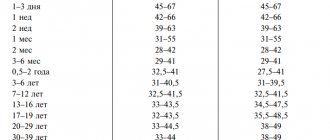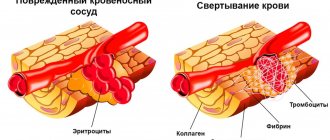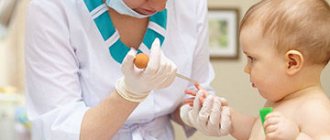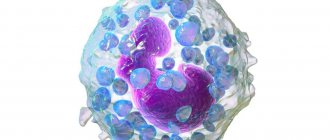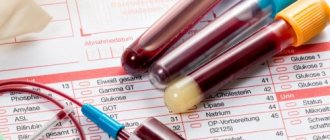The first microscope and red blood cells
The content of the article
At that time, many people in Holland were engaged in grinding optical glasses to make lenses. Leeuwenhoek also became interested in grinding, and achieved high skill in this matter. Its small short-focus biconvex lenses, inserted into a miniature frame of its own design, gave a magnification of 300 times and a very clear image.
With the help of this simple device, three centuries ago A. Leeuwenhoek was able to see red blood cells - erythrocytes, which perform its most important function - supplying tissues with oxygen, a function without which life is impossible.
Many microscopes made by Leeuwenhoek's hands have survived to this day. Although they are not at all similar to modern microscopes, nevertheless, with their help he not only examined red blood cells, but also formed a correct idea of their size.
Important facts about red blood cells
Red blood cells (from the Greek words erythros - red and kytos - cell) make up the bulk of blood. There are 4.6-5.5 million of them per cubic millimeter in men and 4-5 million in women. And in 5-6 liters of blood circulating in the body of an adult, there are approximately 25 trillion red blood cells!
Unlike other cells, the red blood cell does not have a nucleus; its entire volume is filled with hemoglobin - a red protein, a special respiratory pigment. This protein has the amazing ability to easily combine with oxygen, turning into oxyhemoglobin.
The connection occurs in the pulmonary capillaries, where red blood cells come into contact with the air we inhale. Oxygen-enriched scarlet blood flows from the lungs to the heart, and from there through the arteries to all organs and tissues. Having quickly given them oxygen, hemoglobin also quickly combines with carbon dioxide, forming carboxyhemoglobin.
In the lungs, red blood cells give off carbon dioxide (it is removed from the body during exhalation) and again take oxygen into the lungs. In one day, an adult’s red blood cells carry about 800 liters of oxygen and 200 liters of carbon dioxide.
The shape of the red blood cell - in the form of a biconcave disk - provides a relatively large surface for contact of hemoglobin with gases. It is curious that the total surface of red blood cells is about three thousand square meters, that is, one and a half thousand times more than the surface of our body.
Treatment
Pre-hospital assistance
The wound should be covered with a pressure bandage; in case of arterial bleeding, a tourniquet should be applied to the thigh or shoulder. Fractures are fixed using a splint or improvised objects (planks, thick cardboard). A patient with non-traumatic bleeding is provided with complete rest. When bleeding through the mouth, the patient is placed in a position that prevents aspiration. The discharge of blood from the mouth or anus, the occurrence of melena, and vomiting of coffee grounds is a reason to immediately call an emergency medical team.
Conservative therapy
The tactics of conservative treatment are determined by the cause of erythropenia and the existing symptoms. Victims with fractures require immobilization using a plaster cast or skeletal traction. In case of gastric bleeding, an ice pack is placed on the stomach area; in case of pulmonary bleeding, tracheal aspiration is performed. Asphyxia is an indication for immediate intubation, blood removal, and mechanical ventilation.
To correct hypovolemia in erythropenia caused by significant blood loss, infusions of rheopolyglucin, dextran, native plasma or gelatin solution are performed. Posthemorrhagic anemia is eliminated by transfusion of red blood cells. The volume of medical care is determined by the severity of erythropenia, the general condition of the patient, and may include resuscitation measures, monitoring of diuresis and vital signs.
Patients with erythropenia due to vitamin deficiency are prescribed a special diet and vitamin preparations. The underlying pathology that caused the vitamin deficiency is treated. Iron deficiency anemia due to bleeding is considered an indication for the use of iron supplements. In case of hemolytic anemia, red blood cell transfusion is supplemented with glucocorticoids and iron-binding agents.
Treatment of erythropenia against the background of hemoblastosis involves the organization of aseptic conditions, mono- or polychemotherapy, blood transfusion therapy, irradiation of the spleen and lymph nodes. For malignant tumors of various locations, chemotherapy and radiation therapy are prescribed.
Surgery
Taking into account the causes of erythropenia, the following operations are performed:
- Traumatic bleeding
: PSO of wounds and open fractures, thoracotomy or laparotomy with elimination of the source of blood loss. - Gastrointestinal bleeding
: ligation or sclerosis of esophageal veins, endoscopic arrest of gastric or intestinal bleeding by puncture and electrocoagulation, suturing of ulcers, gastric resection, colon resection. - Pulmonary hemorrhage
: endovascular embolization of bronchial arteries, extrapleural filling, thoracoplasty, pulmonary artery ligation, pulmonary resection, pneumonectomy. - Oncological pathologies
: bone marrow transplantation for leukemia, surgical removal of tumors of various locations with part of the affected organ or the entire organ.
Norms of red blood cells
The normal hemoglobin content is 13-18 grams per 100 milliliters of blood, on average about 16. When the necessary tests are carried out in laboratories, this ratio is taken as 100 percent. As a rule, women have less hemoglobin than men, and obese people have more than thin people.
A decrease in the number of red blood cells or a decrease in the hemoglobin content in them leads to oxygen starvation. It happens, for example, to a person who has climbed high into the mountains without special training. He develops the so-called “mountain sickness”: breathing increases sharply, headaches, a feeling of fatigue and a feeling similar to intoxication appear - with nausea, dizziness, and vomiting.
About ten days is enough to acclimatize at an altitude of, say, 4,500 meters. During this time, the body begins to intensively produce red blood cells, and the content of hemoglobin in them increases, and, consequently, the ability of the blood to carry oxygen increases.
This happens not only during acclimatization. Examinations of athletes have shown that in long-distance runners, skiers, cyclists, and rowers, the body's ability to absorb oxygen can double or more. Blood parameters also change accordingly: its volume increases, the number of red blood cells and hemoglobin level increases.
Normal MCV values
| Age, gender | Mean erythrocyte volume, MCV, fl | |
| Children | ||
| 1 day - 14 days | 88,0 — 140,0 | |
| 14 days - 4.3 weeks | 91,0 — 112,0 | |
| 4.3 weeks - 8.6 weeks | 84,0 — 106,0 | |
| 8.6 weeks - 4 months | 76,0 — 97,0 | |
| 4 months – 6 months | 68,0 — 85,0 | |
| 6 months – 9 months | 70,0 — 85,0 | |
| 9 months - 12 months | 71,0 — 84,0 | |
| 12 months - 5 years | 73,0 — 85,0 | |
| 5 years - 10 years | 75,0 — 87,0 | |
| 10 years - 12 years | 76,0 — 90,0 | |
| 12 years - 15 years | Women | 73,0 — 95,0 |
| Men | 77,0 — 94,0 | |
| 15 years - 18 years | Women | 78,0 — 98,0 |
| Men | 79,0 — 95,0 | |
| 18 years - 45 years | Women | 81,0 — 100,0 |
| Men | 80,0 — 99,0 | |
| 45 years - 65 years | Women | 81,0 — 101,0 |
| Men | 81,0 — 101,0 | |
| 65 years - 120 years | Women | 81,0 — 102,0 |
| Men | 83,0 — 103,0 | |
In children under 10 years of age, the index may fluctuate and be inaccurate; later it returns to normal (80-100 fl).
Composition of red blood cells
Over the past two decades, scientists have made particularly great strides in the study of red blood cells. It was possible to determine the structure of the hemoglobin molecule. Not only have all 150 amino acids that make up this molecule been determined, but their location has also been precisely determined.
These data shed light on the cause of a dangerous congenital disease - sickle cell anemia, common in Mediterranean countries. It turned out that this serious illness is caused by the replacement of one of the amino acids in the hemoglobin molecule.
It was also discovered that the deficiency of just one enzyme in the red blood cell leads to intolerance to certain foods and drugs. The results of research at the molecular level expand the possibilities of treatment and prevention of many serious diseases.
Death of red blood cells
Red blood cells are produced continuously throughout a person's life in the bone marrow of the sternum, pelvic bones and in the long tubular bones of the arms and legs. The process of red blood cell maturation has been well studied. Its duration is 3-4 days. During this time, relatively large bone marrow cells with a large nucleus, containing almost no hemoglobin, multiply through a series of successive divisions. Gradually losing their nucleus, they decrease in size, hemoglobin is synthesized in them, and they turn into red blood cells.
But in the process of their life, red blood cells “wear out”. They live no more than 100-120 days, and then are destroyed and removed from the blood by the cells of the spleen and liver. Every day a person loses an average of 115 million red blood cells per minute. To replace them, the bone marrow produces new ones at the same pace.
Red blood cells, first discovered by Leeuwenhoek, have many remarkable properties. One of them cannot be kept silent about. Factors that determine the group properties of blood were discovered in erythrocytes.
Diagnostics
The specialty of the doctor who determines the causes of erythropenia is determined by the nature of the pathology. Patients with bleeding are examined by traumatologists, gastroenterologists, and pulmonologists. Patients with anemia require the help of a hematologist. To determine the severity of erythropenia and clarify the diagnosis, the following studies are prescribed:
- Clinical blood test
. Along with a decrease in the level of red blood cells, a drop in hemoglobin is often detected. Taking into account the characteristics of the disease, leukopenia, thrombocytopenia, reticulocytosis, and macrocytosis are possible. In erythromyelosis, erythroblastic cells are found. - Other laboratory tests
. Hemolytic anemia is accompanied by an increase in the level of bilirubin in a biochemical blood test. A decrease in the amount of B12 and folic acid indicates the development of vitamin deficiency. To confirm the oncological process, biopsies of bone marrow and various organs are taken, followed by morphological analysis. - Visualization techniques
. In patients with hemolytic anemia, an ultrasound scan of the abdominal cavity reveals an enlarged spleen. X-ray, CT scan of the chest, bronchoscopy are informative for pulmonary hemorrhages. Laparoscopy may be required to determine the source of abdominal bleeding. Fractures are diagnosed based on x-rays.
Diagnosis of erythropenia
Blood groups
There are four main blood groups. It turned out that the red cells of people of different blood groups differ in the presence or absence of special proteins in these cells - agglutinogens (antigens), designated by the Latin letters A and B.
Some lack antigens A and B (group 1, “universal” donor), others’ erythrocytes contain only antigen A (group II), others contain only antigen B (group III), and others contain both A and B (group IV , “universal” recipient).
Thus, the blood of not all groups is compatible. And if a person is transfused with blood of an incompatible group, a serious complication will occur - sticking (agglutination) of red blood cells, and then their destruction (hemolysis).
Ideally compatible for the recipient (the person receiving the transfusion) is blood of the same group. But if necessary, you can also use the blood of a “universal” donor. A “universal” recipient can practically receive a blood transfusion of any type.
Blood transfusion and storage
Blood transfusion became possible thanks to the discovery of its group properties. Millions of donors regularly donate blood without any harm to their health. Securely packaged and stored in special bottles, it is delivered to all medical institutions in our country.
The problem of preservation and long-term storage of blood was successfully solved, and they learned how to prepare and use plasma and serum. They are convenient because when transfusing them, you do not need to take into account the compatibility of groups. Scientists have found the opportunity to preserve red blood cells under special conditions, which do not lose their precious properties for years.
Blood transfusion, a humane and powerful means of restoring human health, has become very widespread. The blood of donors brings salvation to people.
Three hundred years ago, A. Leeuwenhoek took the first step in studying blood, which in ancient times was considered a symbol of life. Over the next centuries, scientists around the world devoted a lot of effort and energy to putting life-giving medicine into the hands of doctors - donated blood.
ONLINE REGISTRATION at the DIANA clinic
You can sign up by calling the toll-free phone number 8-800-707-15-60 or filling out the contact form. In this case, we will contact you ourselves.
If you find an error, please select a piece of text and press Ctrl+Enter
Features of the analysis
Today, the mcv test is included in the general blood test or can be performed separately from other indicators. To donate blood, the patient must come to the treatment room, where a laboratory technician or nurse will take blood samples from a finger or vein. Blood sampling is carried out in accordance with all sanitary and epidemiological regulations (SanPiN).
The patient is required to comply with the following rules:
- You need to donate blood on an empty stomach (5-12 hours after your last meal);
- at the time of donation, the woman should not be menstruating;
- feeling normal. It is prohibited to take blood samples if the patient is not feeling well, is in a coma or is in cardiac shock.

